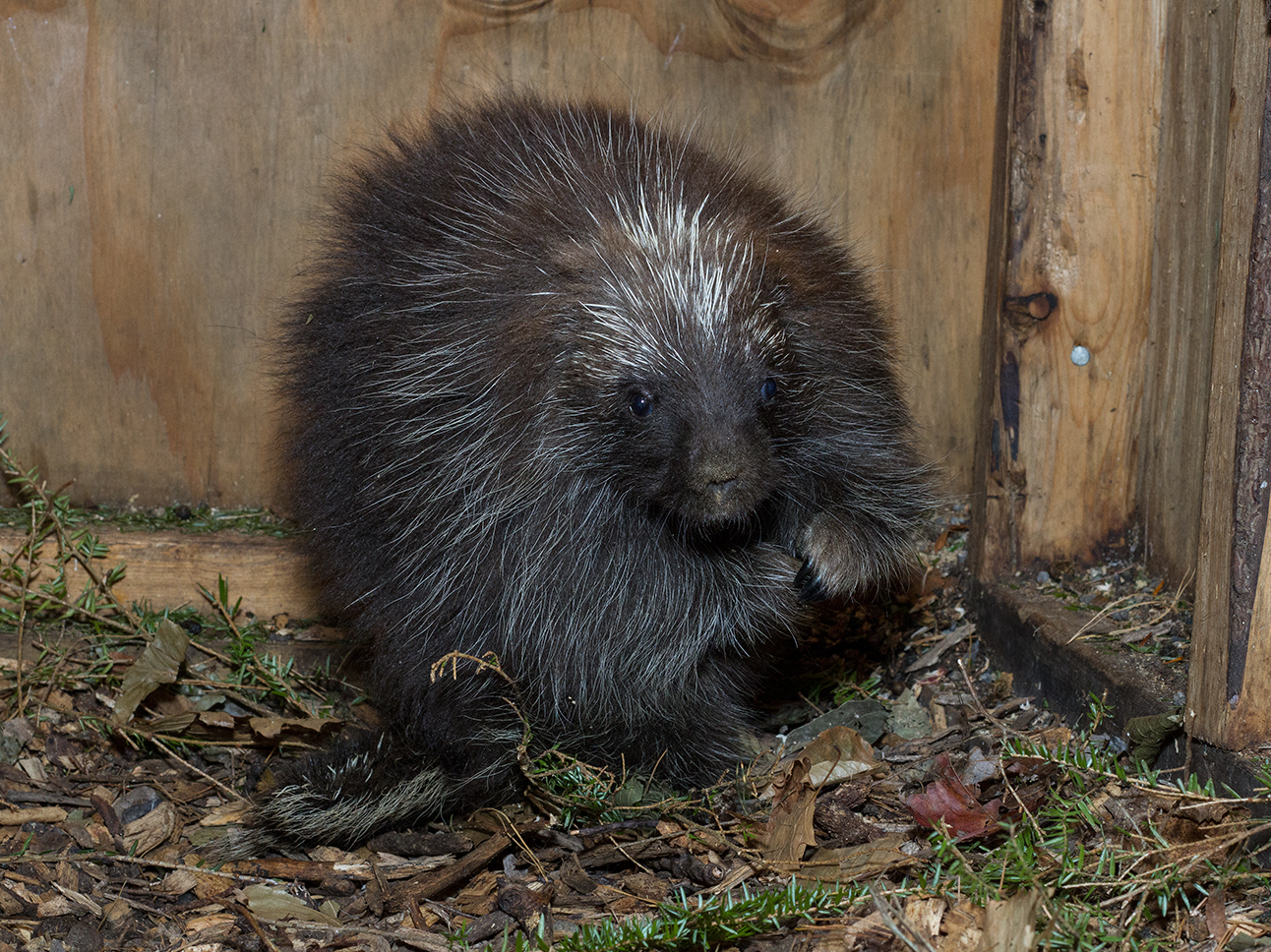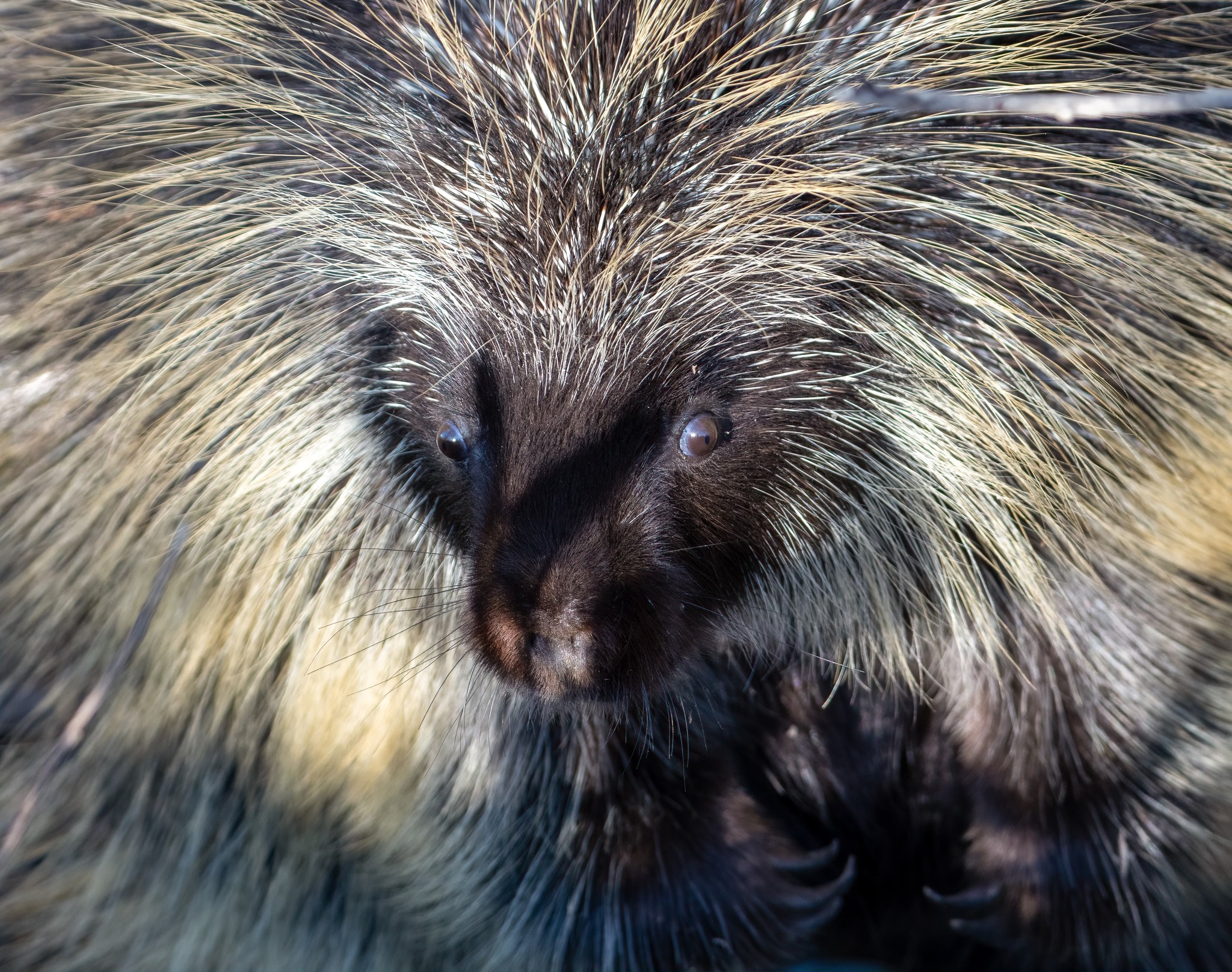|
Porcupine
Porcupines are large rodents with coats of sharp Spine (zoology), spines, or quills, that protect them against predation. The term covers two Family (biology), families of animals: the Old World porcupines of the family Hystricidae, and the New World porcupines of the family Erethizontidae. Both families belong to the infraorder Hystricognathi within the profoundly diverse order (biology), order Rodentia and display superficially similar coats of rigid or semi-rigid quills, which are modified hairs composed of keratin. Despite this, the two groups are distinct from one another and are not closely related to each other within the Hystricognathi. The largest species of porcupine is the third-largest living rodent in the world, after the capybara and beaver. The Old World porcupines (Hystricidae) live in Italy, Asia (western and southern), and most of Africa. They are large, terrestrial, and strictly nocturnal. The New World porcupines (Erethizontidae) are indigenous to North Amer ... [...More Info...] [...Related Items...] OR: [Wikipedia] [Google] [Baidu] |
North American Porcupine
The North American porcupine (''Erethizon dorsatum''), also known as the Canadian porcupine, is a large quill-covered rodent in the New World porcupine family. It is the second largest rodent in North America after the North American beaver (''Castor canadensis''). The porcupine is a Caviomorpha, caviomorph rodent whose ancestors were believed to have Oceanic dispersal, crossed the Atlantic from Africa to Brazil 30 million years ago, and then migrated to North America during the Great American Interchange after the Isthmus of Panama rose 3 million years ago. Etymology The word "porcupine" comes from the middle or old French word , which means 'thorn pig'. Its roots derive from the Latin words or pig and meaning thorns. Other colloquial names for the animal include quill pig. It is also referred to as the Canadian porcupine or common porcupine. The porcupine's scientific name, ''Erethizon dorsatum'', can be loosely translated as "the animal with the irritating back". Indigenous t ... [...More Info...] [...Related Items...] OR: [Wikipedia] [Google] [Baidu] |
Old World Porcupine
The Old World porcupines, or Hystricidae, are large terrestrial rodents, distinguished by the spiny covering from which they take their name. They range over Southern Europe and the Levant, most of Africa, India, and Southeast Asia as far east as Flores. Although both the Old World and New World porcupine families belong to the infraorder Hystricognathi of the vast order Rodentia, they are quite different and are not particularly closely related. Characteristics Old World porcupines are stout, heavily built animals, with blunt, rounded heads, fleshy, mobile snouts, and coats of thick cylindrical or flattened spines, which form the whole covering of their bodies, and are not intermingled with ordinary hairs. The habits of most species are strictly terrestrial. They vary in size from the relatively small long–tailed porcupine with body lengths of , and a weight of , to the much larger crested porcupines, which are long, discounting the tail, and weigh from . The various speci ... [...More Info...] [...Related Items...] OR: [Wikipedia] [Google] [Baidu] |
New World Porcupine
The New World porcupines, family Erethizontidae, are large arboreal rodents, distinguished by their Spine (zoology), spiny coverings from which they take their name. They inhabit forests and wooded regions across North America, and into northern South America. Although both the New World and Old World porcupine families belong to the Hystricognathi branch of the vast order (biology), order Rodentia, they are quite different and are not closely related. Characteristics New World porcupines are stout animals, with blunt, rounded heads, fleshy, mobile snouts, and coats of thick, cylindrical or flattened spines. The "quills" are mixed with long, soft hairs. They vary in size from the relatively small prehensile-tailed porcupines, which are around long, and weigh about , to the much larger North American porcupine, which has a body length of , and weighs up to . They are distinguished from the Old World porcupines in that they have rooted Molar (tooth), molars, complete collar bone ... [...More Info...] [...Related Items...] OR: [Wikipedia] [Google] [Baidu] |
Spine (zoology)
In a zoological context, spines are hard, needle-like anatomical structures found in both vertebrate and invertebrate species. The spines of most spiny mammals are modified hairs, with a spongy center covered in a thick, hard layer of keratin and a sharp, sometimes barbed tip. Occurrence Mammals Spines in mammals include the prickles of hedgehogs, and among rodents, the quills of porcupines (of both the New World and the Old), as well as the prickly fur of spiny mice, spiny pocket mice, and of species of spiny rat. They are also found on afrotherian tenrecs of the family Tenrecinae (hedgehog and streaked tenrecs), marsupial spiny bandicoots, and on echidnas (a monotreme). An ancient synapsid, ''Dimetrodon'', had extremely long spines on its backbone that were joined together with a web of skin that formed a sail-like structure. Many mammalian species, like cats and fossas, also have penile spines. The Mesozoic eutriconodont mammal '' Spinolestes'' already displa ... [...More Info...] [...Related Items...] OR: [Wikipedia] [Google] [Baidu] |
Rodent
Rodents (from Latin , 'to gnaw') are mammals of the Order (biology), order Rodentia ( ), which are characterized by a single pair of continuously growing incisors in each of the upper and Mandible, lower jaws. About 40% of all mammal species are rodents. They are native to all major land masses except for Antarctica, and several oceanic islands, though they have subsequently been introduced to most of these land masses by human activity. Rodents are extremely diverse in their ecology and lifestyles and can be found in almost every terrestrial habitat, including human-made environments. Species can be arboreal, fossorial (burrowing), saltatorial/ricochetal (leaping on their hind legs), or semiaquatic. However, all rodents share several morphological features, including having only a single upper and lower pair of ever-growing incisors. Well-known rodents include Mouse, mice, rats, squirrels, prairie dogs, porcupines, beavers, Cavia, guinea pigs, and hamsters. Once included wi ... [...More Info...] [...Related Items...] OR: [Wikipedia] [Google] [Baidu] |
Echimyidae
Echimyidae is the family of neotropical spiny rats and their fossil relatives. This is the most species-rich family of hystricognath rodents. It is probably also the most ecologically diverse, with members ranging from fully arboreal to terrestrial to fossorial to semiaquatic habits. They presently exist mainly in South America; three members of the family also range into Central America, and the hutias are found in the West Indies in the Caribbean. Species of the extinct subfamily Heteropsomyinae formerly lived on Cuba, Hispaniola, and Puerto Rico in the Antilles. Characteristics In general form, most spiny rats resemble rats, although they are more closely related to guinea pigs and chinchillas. Most species have stiff, pointed hairs, or Spine (zoology), spines, that presumably serve for protection from predators. Many echimyids can Autotomy, break off their tails when attacked. This action may confuse predators long enough for the spiny rat to escape. Unlike the tai ... [...More Info...] [...Related Items...] OR: [Wikipedia] [Google] [Baidu] |
Bathyergoididae
''Bathyergoides'' is an extinct genus of rodent from Africa thought to be related to the modern blesmols. It is the only member of the family Bathyergoididae. Fossils of ''Bathyergoides neotertiarius'' were recovered from the Early Miocene Elisabeth Bay Formation of Namibia Namibia, officially the Republic of Namibia, is a country on the west coast of Southern Africa. Its borders include the Atlantic Ocean to the west, Angola and Zambia to the north, Botswana to the east and South Africa to the south; in the no ....Pickford, 2018, p. 88 References Bibliography * Phiomorpha Monotypic prehistoric rodent genera Miocene rodents Miocene mammals of Africa Fossils of Namibia Fossil taxa described in 1926 Taxa named by Ernst Stromer {{paleo-rodent-stub ... [...More Info...] [...Related Items...] OR: [Wikipedia] [Google] [Baidu] |
Family (biology)
Family (, : ) is one of the eight major hierarchical taxonomic ranks in Linnaean taxonomy. It is classified between order and genus. A family may be divided into subfamilies, which are intermediate ranks between the ranks of family and genus. The official family names are Latin in origin; however, popular names are often used: for example, walnut trees and hickory trees belong to the family Juglandaceae, but that family is commonly referred to as the "walnut family". The delineation of what constitutes a family—or whether a described family should be acknowledged—is established and decided upon by active taxonomists. There are not strict regulations for outlining or acknowledging a family, yet in the realm of plants, these classifications often rely on both the vegetative and reproductive characteristics of plant species. Taxonomists frequently hold varying perspectives on these descriptions, leading to a lack of widespread consensus within the scientific community ... [...More Info...] [...Related Items...] OR: [Wikipedia] [Google] [Baidu] |
Predation
Predation is a biological interaction in which one organism, the predator, kills and eats another organism, its prey. It is one of a family of common List of feeding behaviours, feeding behaviours that includes parasitism and micropredation (which usually do not kill the Host (biology), host) and parasitoidism (which always does, eventually). It is distinct from Scavenger, scavenging on dead prey, though many predators also scavenge; it overlaps with Herbivore, herbivory, as Seed predation, seed predators and destructive frugivores are predators. Predation behavior varies significantly depending on the organism. Many predators, especially carnivores, have evolved distinct hunting strategy, hunting strategies. Pursuit predation involves the active search for and pursuit of prey, whilst ambush predation, ambush predators instead wait for prey to present an opportunity for capture, and often use stealth or aggressive mimicry. Other predators are opportunism, opportunistic or om ... [...More Info...] [...Related Items...] OR: [Wikipedia] [Google] [Baidu] |
Heptaxodontidae
Heptaxodontidae, rarely called giant hutia, is an extinct family (taxonomy), family of large rodents known from fossil and subfossil material found in the West Indies. One species, ''Blunt-toothed giant hutia, Amblyrhiza inundata'', is estimated to have weighed between , reaching the weight of an eastern gorilla. This is twice as large as the capybara, the largest rodent living today, but still much smaller than ''Josephoartigasia monesi'', the largest rodent known. These animals were probably used as a food source by the pre-Columbian peoples of the Caribbean. Heptaxodontidae contains no living species and the grouping seems to be paraphyletic and arbitrary, however. One of the smaller species, ''Twisted-toothed mouse, Quemisia gravis'', may have survived as late as when the Spanish began to colonize the Caribbean. Despite the vernacular name, heptaxodontids are not closely related to the extant hutias of the family Echimyidae. Heptaxodontids are thought to be more closely rel ... [...More Info...] [...Related Items...] OR: [Wikipedia] [Google] [Baidu] |




